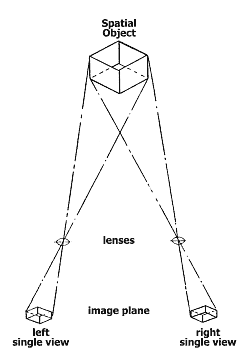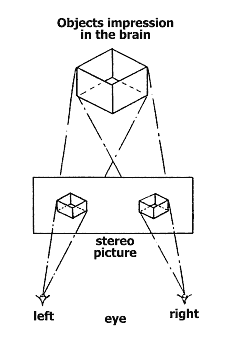


| STEREO PHOTOGRAPHY
1. WHAT IS STEREO OR 3-D ? |
The word "stereo" originates from the Greek and means "relating to space". Today when we talk about stereo we usually refer to stereophonic sound. Originally the term was associated with stereoscopic pictures, which were either drawn or photographed. In order to avoid confusion with stereophonic sound, one now often talks about 3-D pictures and especially 3-D-film, where 3-D, of course, stands for three-dimensional.
A person lives in a three-dimensional, spatial, environment. Without a feeling for space, we can not move within it. Our perception of space is created almost exclusively by our eyes. There are many ways to orient oneself in space, e.g., by perspective, gradation of color, contrast and movement.
The lenses of the eyes in a healthy human being project two slightly different pictures onto the retinas, which are then transformed, by the brain, into a spatial representation. The actual stereoscopic spatial observation is a result of this perception through both eyes.
A number of otherwise healthy two-eyed people, however, have eye-defects since birth, that make stereoscopic viewing impossible. As babies, they have, in the literal sense of the word, learned to "grasp" the world. They safely orient themselves in their environment by employing one of the other above mentioned methods. Even a person with only one eye learns how to move around safely, using non stereoscopic cues.
The normal picture on paper or film is only one-eyed. It is photographed with only one lens and can, therefore, not convey a true spatial perception. It is only a flat picture. But we do not have to abstain from the known natural effect. By taking two lenses and imitating the eyes, we can create such a space image (fig. 1.1).
When we examine with or without optical
instruments a stereo picture created in such a manner', we form a similar
perception of space in our mind (fig. 1.2).

|

|
|
|
|
The two necessary, somewhat different,
single views can be generated by different methods. We can produce them
like the old stereo artists did, first draw one, then the other single
view. We may also take the exposure one after the other with a normal single
lens camera (fig. 1.3a) It is evident that the subject must not move during
this procedure, otherwise the two pictures would be too different. A better
approach is to imitate the head and mount both lenses in a common chassis.
Now we have a true stereo camera (fig. 1.3b). Basically it is only the
joining of two mono-cameras. It is also possible to take stereo pictures
with two coupled cameras (fig. 1.3c). The two lenses can also be combined
as interchangeable stereo optics in a single camera (fig. 1.3d).

|
|
|
It is also possible to make two exposures
with only one lens by placing a beamsplitter attachment in front of this
lens. The splitter is constructed from mirrors, prisms, or a combination
of both. This divides the optical path so that two separate pictures are
formed on a single film frame (fig. 3e).
| Previous
Chapter: Condensed Stereo Rules |
Contents |
Next
Chapter: A Little History |
 |
|

| Back to the Services Page |
